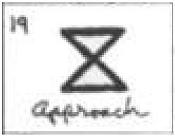
Illustration by Frederick Alfred Rhead of Vanity Fair,
page 96 in the John Bunyan classic Pilgrim's Progress
(New York, The Century Co., 1912)
Detail of illustration by Frederick Alfred Rhead of Vanity Fair,
page 96 in the John Bunyan classic Pilgrim’s Progress
(New York, The Century Co., 1912)
"In those days, the occult sciences were cultivated with ardor well calculated to surprise the incredulous minds of our own sovereignly analytical age; perhaps they may detect in this historical sketch the germ of the positive sciences, widely studied in the nineteenth century, but without the poetic grandeur which was ascribed to them by the audacious investigators of the sixteenth century; who, instead of devoting their energy to industry, magnified art and made thought fruitful. The patronage universally accorded to art by the sov- ereigns of that time was justified, too, by the mar- vellous creations of inventors who started in quest of the philosopher's stone and reached amazing re- sults." — Balzac, Catherine de' Medici
Honoré de Balzac, Sur Catherine de Médicis :
— Hé! bien, sire, en ôtant Dieu de ce monde, que reste-t-il?
L’homme! Examinons alors notre domaine?
Le monde matériel est composé d’éléments, ces éléments
ont eux-mêmes des principes. Ces principes se résolvent
en un seul qui est doué de mouvement. Le nombre TROIS est
la formule de la création: la Matière, le Mouvement, le Produit!
— La preuve? Halte-là, s’écria le roi.

Illustration by Frederick Alfred Rhead of Vanity Fair,
page 96 in the John Bunyan classic Pilgrim's Progress
(New York, The Century Co., 1912)
A version of the I Ching’s Hexagram 19:

From Katherine Neville's The Eight , a book on the significance
of the date April 4 — the author's birthday —

|
The Eight by Katherine Neville —
“What does this have to do with why we’re here?” |
Related material: Posts now tagged Hourglass Code.
See also the hourglass in a search for Pilgrim's Progress Illustration.
Detail of illustration by Frederick Alfred Rhead of Vanity Fair,
page 96 in the John Bunyan classic Pilgrim's Progress
(New York, The Century Co., 1912)
Yesterday's posts Legend and Purple Requiem suggest a review
of John Bunyan. A search for "Vanity Fair" + "Temple of Art" yields…
The above Vanity Fair article was linked to here previously.
Vanity Fair illustrated —
Detail of illustration by Frederick Alfred Rhead of Vanity Fair,
page 96 in the John Bunyan classic Pilgrim's Progress
(New York, The Century Co., 1912)
See also …
Literary Landmarks
From Dr. Mac's Cultural Calendar for Oct. 3:
"On this day in 1610, Ben Jonson's funniest comedy The Alchemist was entered into the Stationer's Register. It involves a servant who when the masters are away sets up a necromantic shop, tricking all and everyone."
From Literary Calendar for tomorrow, Oct. 4:
"1892 — Robert Lawson, the only author/illustrator to win both the Caldecott Award and the Newbery Award—both coveted awards in the United States for children's literature, is born."
As a child I was greatly influenced by Robert Lawson's illustrations for the Godolphin abridgement of Pilgrim's Progress. Later I was to grow up partly in Cuernavaca, Mexico, an appropriate setting for The Valley of the Shadow of Death and other Bunyan/Lawson themes. Still later, I encountered Malcolm Lowry's great novel Under the Volcano, set in Cuernavaca. Lowry's novel begins with an epigraph from Bunyan. For the connection with Ben Jonson, see Pete Hamill's article "The Alchemist of Cuernavaca" in Art News magazine, April 2001, pages 134-137. See also my journal note of April 4, 2001, The Black Queen.
Powered by WordPress